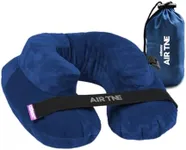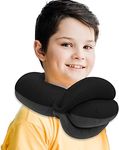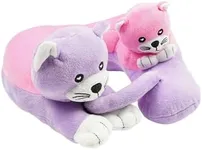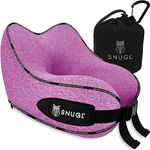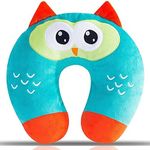Buying Guide for the Best Kids Travel Pillows
Choosing the right travel pillow for kids can make journeys much more comfortable and enjoyable for your child. The right pillow helps support their neck and head, making it easier for them to rest or sleep during car rides, flights, or train trips. When shopping for a kids' travel pillow, it's important to consider factors that affect comfort, safety, and practicality. Understanding the key features will help you select a pillow that matches your child's age, travel habits, and personal preferences.Size and FitSize and fit refer to how well the pillow matches your child's body and neck. A pillow that's too large or too small won't provide proper support and could even be uncomfortable. Travel pillows for kids are usually designed for specific age ranges or body sizes. For younger children, look for smaller, lightweight pillows that fit snugly around their necks without restricting movement. Older kids may need slightly larger pillows for better support. Always check the recommended age or size range and, if possible, have your child try the pillow to ensure it fits comfortably.
Shape and DesignThe shape and design of a travel pillow determine how it supports your child's head and neck. Common shapes include U-shaped, rectangular, and wrap-around designs. U-shaped pillows are popular because they cradle the neck and prevent the head from falling forward. Wrap-around designs offer more all-around support, which can be helpful for restless sleepers. Some pillows have fun animal shapes or characters, which can make them more appealing to kids. Consider your child's sleeping habits and preferences—if they tend to lean to the side, a pillow with side support might be best.
Material and FillingMaterial and filling affect the pillow's comfort, breathability, and durability. Common fillings include memory foam, microbeads, and polyester fiber. Memory foam offers firm, contoured support but can be heavier and less breathable. Microbeads are lightweight and moldable, making them easy to adjust, but they may not last as long. Polyester fiber is soft and lightweight, but may flatten over time. The outer fabric should be soft, hypoallergenic, and easy to clean. Choose a material that matches your child's comfort needs and any sensitivities they may have.
PortabilityPortability refers to how easy it is to carry and store the pillow when not in use. Some travel pillows are inflatable, allowing you to deflate and pack them flat, which saves space in your luggage. Others come with carrying cases or clips to attach to backpacks. If you travel frequently or have limited space, a compact or inflatable pillow may be more convenient. Think about how your child will carry the pillow and whether it needs to fit in a backpack or suitcase.
WashabilityWashability is important because kids' travel pillows can easily get dirty during trips. Some pillows have removable, machine-washable covers, while others can be washed entirely. Easy cleaning helps maintain hygiene and keeps the pillow fresh for every trip. If your child is prone to spills or allergies, prioritize pillows that are simple to clean and dry quickly.
Safety FeaturesSafety features ensure that the pillow is suitable for children and won't pose any risks. Look for pillows made from non-toxic materials and free from small detachable parts that could be a choking hazard. Some pillows have safety certifications or meet specific standards for children's products. Always check for age recommendations and avoid pillows with features that could restrict breathing or movement.




